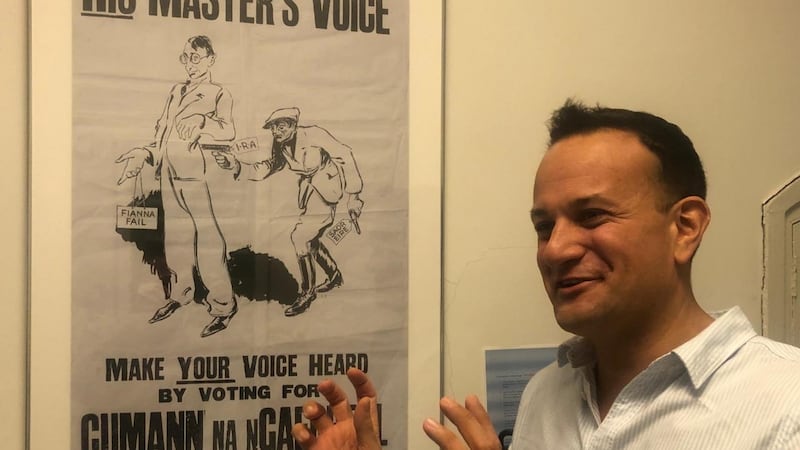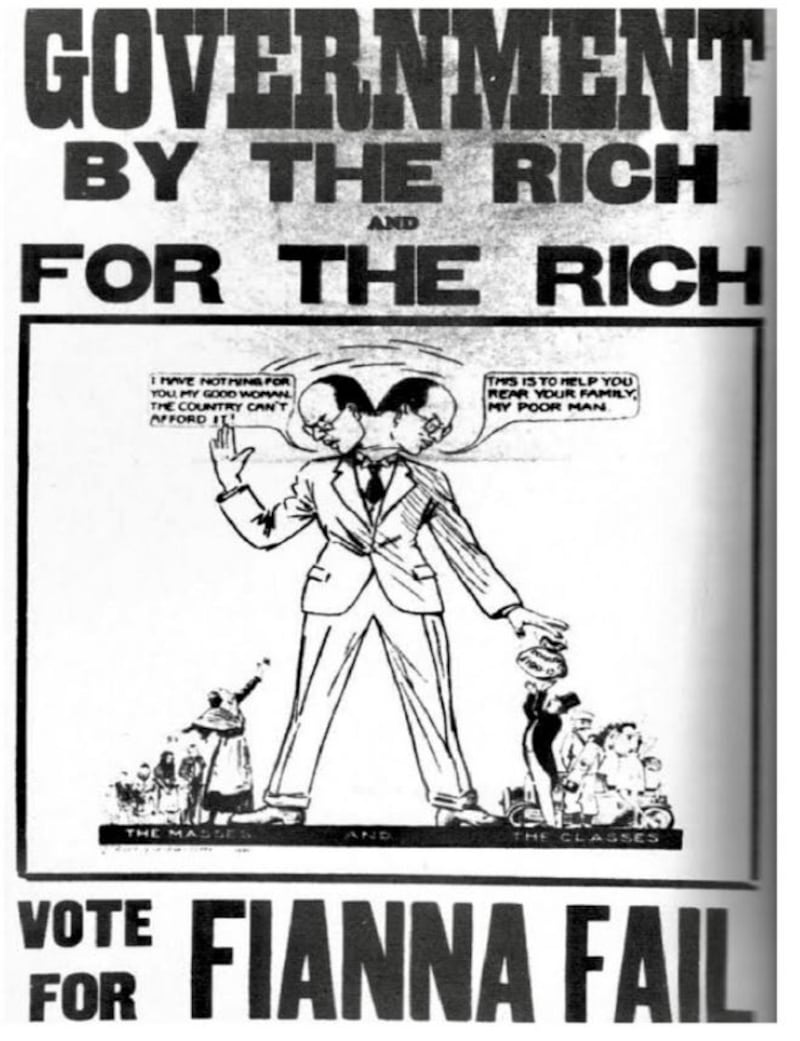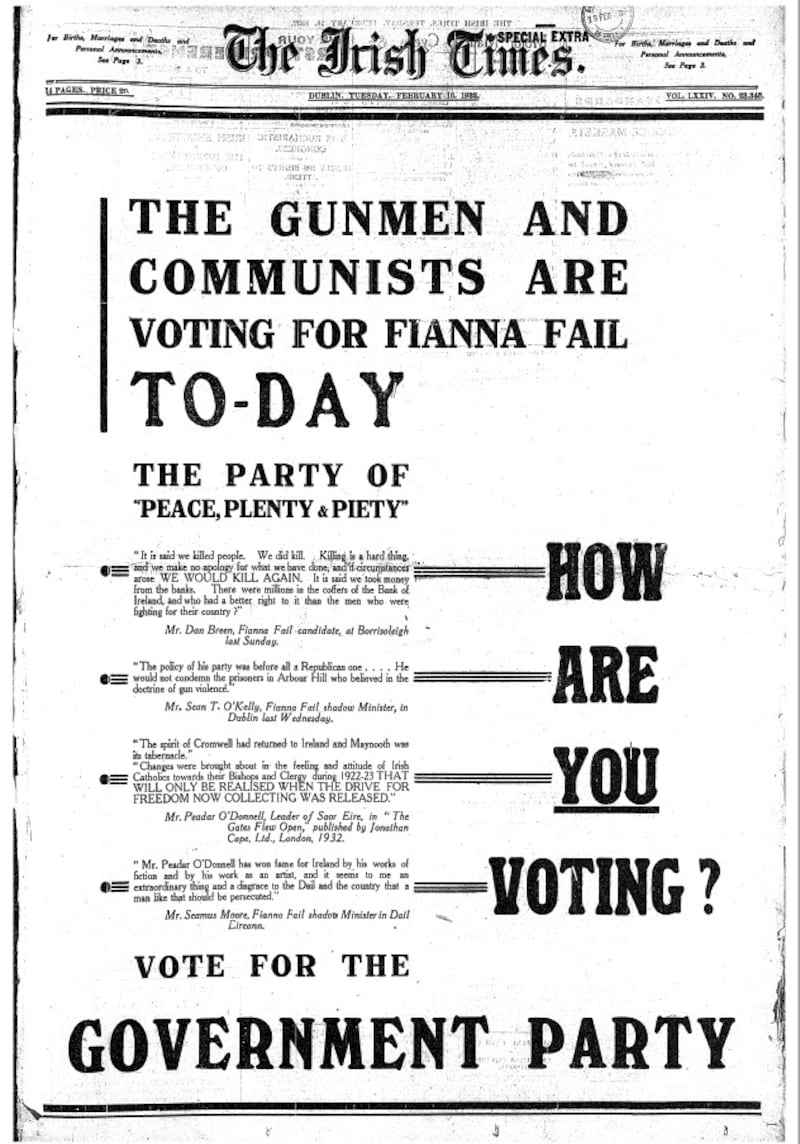It was a February election in which the government had been in power for a decade and was accused of being out-of-touch and elitist.
The government party in turn accused the main opposition of being run by shadowy gunmen and of having policies that would bankrupt the State.
The parallels between the 1932 general election, the most important in the history of the State, and the current election, do not end there.
The Cumann na nGaedheal government was accused of being wasteful with public money in the depths of the Great Depression. The Shannon scheme, the children's hospital of its day, ran three times over budget. There was also a Royal Irish Constabulary (RIC) legacy, a dispute over who should pay their pensions, which Fianna Fáil used to smear Cumann na nGaedheal as a party of west Brits.
Like their modern-day descendants in Fine Gael, Cumann na nGaedheal had a foreign policy triumph it could not exploit at the ballot box. The Statutes of Westminster in 1931 was the Brexit issue of the day. It enshrined in law the autonomous nature of the dominions within the British Empire of the Irish Free State, Australia, New Zealand and South Africa.
However, Cumann na nGaedheal was acutely sensitive to criticism that it was too deferential towards the British.

As Tim Pat Coogan has pointed out: "He (WT Cosgrave, the president of the Executive Council) had to mute his quite substantive triumphs in Anglo-Irish relations lest he give aid and comfort to both British conservatives and Irish Republicans".
Class warfare
In response to Fianna Fáil leader Micheál Martin's claim that Fine Gael was the party of privilege, the Taoiseach Leo Varadkar suggested there has never been "class war in Irish politics and it shouldn't start now".
This is incorrect. Class warfare was present from the beginning in the battle between the State’s two big parties. The Treaty was not the only thing that divided them.
Cumann na nGaedheal, the forerunner of Fine Gael, was relentlessly pilloried as a party of west Brit toffs. Their leadership was often caricatured in the political cartoons of the time as wearing top hats and tails, the unofficial uniform of the British establishment.
The association of Cumann na nGaedheal with privilege was exemplified in Fianna Fáil's 1932 general election poster slogan paraphrasing Abraham Lincoln: "Government by the rich for the rich". By contrast, Fianna Fáil promised the 1932 equivalent of "an Ireland for all".

At a time of austerity, in which public pay was cut, Fianna Fáil regularly raised the cost of keeping the office of the governor-general of the Irish Free State, the British king’s representative in Ireland.
Cumann na nGaedheal hit back by attempting to smear Fianna Fáil as a party in thrall to sinister forces. Its most famous election poster “the Shadow of a Gunman, keep it from your home” sought to portray Fianna Fáil as a party which had a legacy of violence in ways that will be familiar to the modern-day taunts directed at Sinn Féin.
Taoiseach Leo Varadkar has a daily reminder of this campaign in his office as a party poster from 1932. It portrays de Valera with a gun jammed into his back by an IRA gunman. It also references Saor Éire, a revolutionary, republican organisation founded in 1931 which was associated with communism.
Cumann na nGaedheal sought to exploit the notion that Fianna Fáil was a party in thrall to communists. Fanciful as it seems now, given Éamon de Valera’s subsequent record, this was a real fear at the time. Moreover, Cumann na nGaedheal described de Valera’s policies as “un-Irish and un-Catholic”.

It was articulated in a famous front page Irish Times advertisement taken out by Cumann na nGaedheal on the morning of the election, February 16th 1932: “The gunmen and Communists are voting for Fianna Fáil today - vote for the Government party”.
Cumann na nGaedheal ran on its record and its campaign was mostly negative. It offered no solutions to the problems of unemployment and poverty which were rife in Ireland at the time, instead emphasising its status as a safe pair of hands at a time of global turbulence.
The continual scare tactics would appear to have been an example of the law of diminishing returns similar to the way that repeated warnings about contemporary Sinn Féin and its links to the IRA appear to be diminishing with a new generation given the opinion polls.
Fianna Fáil victory
The Irish public was no longer interested as the historian Mel Farrell points out in his book Party Politics in a New Democracy: The Irish Free State, 1922-37: "In September 1927, Fianna Fáil was an unknown quantity. By 1932, it was just like any other party thereby undermining Cumann na nGaedheal's negative campaign. This time, the circumstances suited de Valera and his party appealed to new and first time voters.
"His arguments for an alternative approach seemed insurmountable given the scale of change occurring across Europe. Fianna Fáil was able, successfully, to exploit the economic discontent and challenged Cumann na nGaedheal's orthodoxies by promising increased welfare measures and the implementation of protectionism".
The result of the 1932 general election was a victory for Fianna Fáil. The party increased its seats from 57 to 72 and its percentage share of the vote from 35.2 per cent to 44.5 per cent. Cumann na nGaedheal declined from 38.6 per cent to 35.2 per cent and it lost eight seats.
Fianna Fáil fell five seats short of a majority and was able to form a government with the support of the Labour Party. Unhappy with his slim mandate, de Valera called a snap election in January 1933. This time he won a majority of one, but widened his margin of victory over Cumann na nGaedheal winning 76 seats as against his opponents 48. Fianna Fáil's status as the largest party would last until 2011.
The fears over Fianna Fáil being controlled by shadowy gunmen proved unfounded. De Valera angered many of his old anti-Treaty comrades by banning the IRA in 1936. Six IRA men were executed during the Second World War.
He also proved to be as punctilious in his relation with the Catholic Church as his predecessors had been.
The most important thing about the 1932 general election is that there was a peaceful handover of power from one bitter rival to another as Farrell points out: “Nine years after the end of the Civil War, there was a peaceful and democratic handover of power from its victors to its vanquished - something that is noteworthy when we look at the turbulent history of Europe during the 1930s.”











